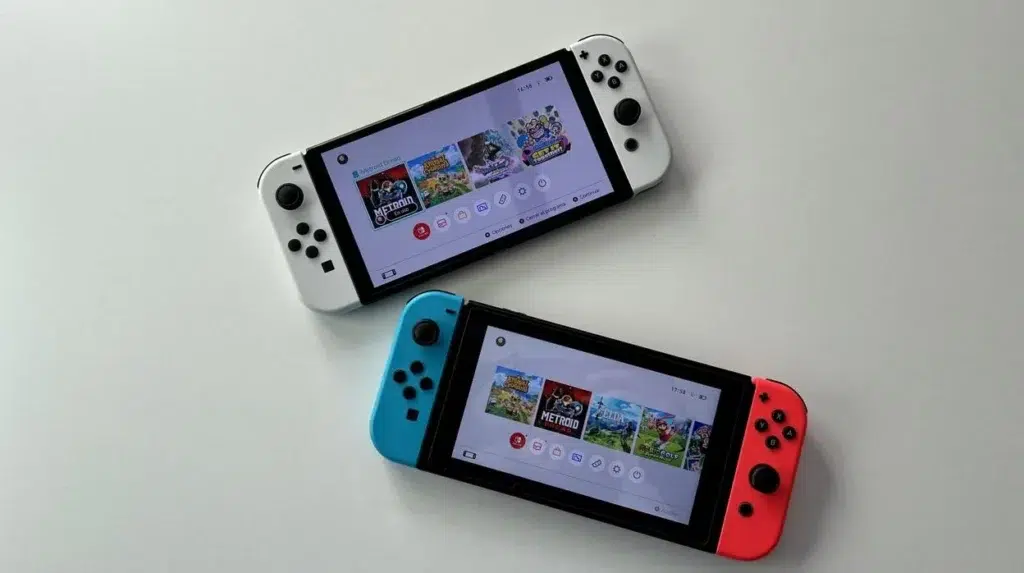
La Nintendo Switch was launched in 2017 with a very original proposal, a hybrid console. In the heat of the sales success, an improved update appeared (also called V2) and finally in 2021 the company decided to market the OLED version. In this article we are going to analyze both consoles to discover What's the difference between the Nintendo Switch and the Nintendo Switch OLED?
The truth is that, at first glance, both consoles have great similarities. Their external appearance is almost the same. Obviously, there are differences that go beyond aesthetics. Below, we will review the specifications of each model and establish a reliable comparison.
We will now focus on the Nintendo Switch V2, better known as the "normal Nintendo Switch" and the Nintendo Switch OLED, leaving the analysis of the no less interesting Lite version for another occasion:
Nintendo Switch – Specifications
- Year of release: 2021
- Dimensiones: 10,16 cm high x 23,88 cm wide x 1,4 cm long / Weight: 299 grams.
- Screen: 6,2 inch capacitive multi-touch LCD, 1280 x 720 resolution.
- CPU/GPU: NVIDIA Custom Tegra processor.
- Storage: 32 GB, expandable with microSDHC or microSDXC cards up to 2 TB.
- Connectivity: Wi-Fi, HDMI, Bluetooth 4.1, USB Type-C, 3,55 mm audio connector with 4 poles.
- Sensors: Accelerometer, gyroscope and brightness sensor.
- Battery 4310 mAh lithium-ion battery / Up to 9 hours of battery life (depending on the game) / Charging time: 3 hours.
- Energy consumption: maximum 7 W.
- Price: Alrededor de 300 euros.
Nintendo Switch OLED – Specifications

- Year of release: 2021
- Dimensiones: 10,16 cm high x 24,13 cm wide x 1,4 cm long / Weight: 322 grams.
- Screen: 7-inch capacitive multi-touch OLED, 1280 x 720 resolution.
- CPU/GPU: NVIDIA Custom Tegra processor.
- Storage: 64 GB, expandable with microSDHC or microSDXC cards up to 2 TB.
- Connectivity: Wi-Fi, HDMI, Bluetooth 4.1, USB Type-C, 3,55 mm audio connector with 4 poles.
- Sensors: Accelerometer, gyroscope and brightness sensor.
- Battery 4310 mAh lithium-ion battery / Up to 9 hours of battery life (depending on the game) / Charging time: 3 hours.
- Energy consumption: maximum 6 W.
- Price: Unos 350 euros.
Nintendo Switch vs Nintendo Switch OLED: Comparison
Below, we analyze all the features of both consoles, one by one:
Dimensions and weight
Both consoles are prácticamente iguales in size (the Nintendo Switch OLED is slightly wider), although the original console is about 20 grams lighter. In any case, this does not affect portability, because the ergonomic design is the same.
Screen
The original Nintendo Switch features a 6,2-inch LCD screen. As its name suggests, the other console has a XNUMX-inch LCD screen. OLED screen. Not only is it bigger (reaching 7 inches), but it offers more vibrant colors, deep blacks and superior contrast. All of this means being able to enjoy a more immersive visual experience.
Sound
Also in this section The Nintendo Switch OLED is a step above the standard version of this console. The original speakers may be insufficient when we aspire to enjoy a more immersive experience. In the most recent version, the audio is clearer and crisper.
Performance
Both consoles are almost twins in terms of performance, since both share the NVIDIA Tegra processor.
Storage
The standard model of the Nintendo Switch has 32 GB of internal storage, more than enough for many games, although not for the heaviest titles. The Nintendo Switch OLED doubles this internal storage capacity, offering 64 GB. However, to enjoy certain games there is no choice but to expand this capacity using a microSD card.
Battery
No significant differences are seen between the two versions. Both models move in a range of battery life that goes from 4,5 to 9 hours., depending on the level of demand of each game, of course. It could end in a draw.
Conexión a la TV
Part of the popularity achieved by Nintendo Switch is due to the possibility of alternating the game mode: we can choose to play on its own screen or connect to a TV. For this purpose, both models have a base (dock) on which to place the console and connect it to the TV using an HDMI cableThe only difference is that the Nintendo Switch OLED allows us to make this connection both by cable and by WiFi.
Which one is better?
After analyzing all the aspects of each of the consoles, each user will have a clearer decision between choosing Nintendo Switch and Nintendo Switch OLED.
Many users may think that the "normal" console is already sufficient for what they need, or that perhaps the Switch OLED is a little over their budget. The truth is, considering that The price difference between the two is around 50 euros., it is probably worth opting for the more modern version, which offers greater storage capacity as well as better image quality.
See also: Best Nintendo Switch Games for Every Type of Gamer
Editor specialized in technology and internet issues with more than ten years of experience in different digital media. I have worked as an editor and content creator for e-commerce, communication, online marketing and advertising companies. I have also written on economics, finance and other sectors websites. My work is also my passion. Now, through my articles in Tecnobits, I try to explore all the news and new opportunities that the world of technology offers us every day to improve our lives.
